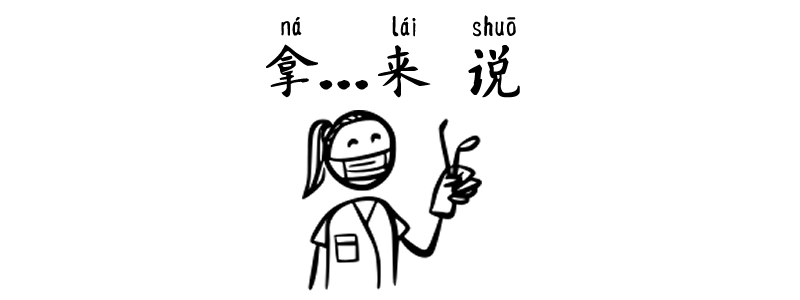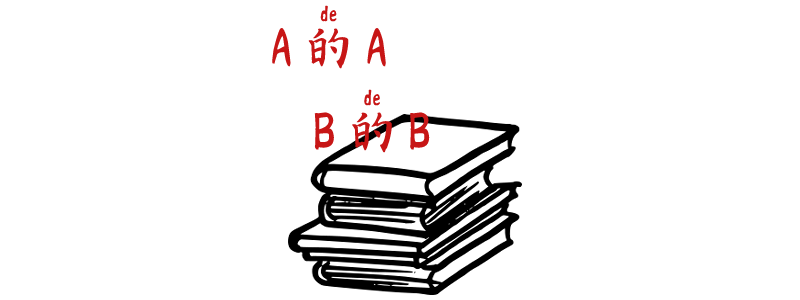Grammar Point:從从而 cóng’ér is a formal conjunction used to indicate a cause-and-effect or means-and-result relationship between two clauses. It can be translated as “thus,” “thereby,” or “consequently” in English. Structure Cause or method + 從从而 cóng’ér + resulting 從从而 cóng’ér is mainly used in formal writing, such as essays, reports, and news articles, to emphasize a logical result following a cause or method. While it…
Category: HSK 5
Using 将 jiāng to express 把 bǎ
Grammar Point:In Chinese grammar, 將将 jiāng can function similarly to 把 bǎ when constructing sentences that emphasize the handling or disposition of an object. But 將将 jiāng is more formal and is often used in written or official contexts, whereas 把 bǎ is more commonly used in spoken Chinese. If you are not familiar with 把 bǎ, I recommend reading this article first.What…
Giving An Example – 拿 ná… 来说 láishuō
Grammar Point:The Chinese structure 拿 ná… 來說来说 láishuō is commonly used to give an example in conversation or writing. It can be translated as “take…for example” or “speaking of…”. Structure 拿 ná + example + 來說来说 láishuō 拿ná日本rìběn來說láishuō, 他們tāmen的de公共gōnggòng交通jiāotōng非常fēicháng準時zhǔnshí拿ná日本rìběn来说láishuō, 他们tāmen的de公共gōnggòng交通jiāotōng非常fēicháng准时zhǔnshíTake Japan, for example; their public transportation is extremely punctual. 拿ná中國Zhōngguó菜cài來說láishuō, 每個měige地區dìqū都dōu有yǒu自己zìjǐ的de特色tèsè口味kǒuwèi拿ná中国Zhōngguó菜cài来说láishuō, 每个měige地区dìqū都dōu有yǒu自己zìjǐ的de特色tèsè口味kǒuwèiTake Chinese food, for example; every…
“Sufficiently” in Chinese – 够 gòu… 的 de
Grammar Point:This structure 夠够 gòu …的 de is used to express that something is “enough to reach a certain extent” or “sufficiently.” It emphasizes the degree or extent of a quality, often to highlight how remarkable or notable something is. Structure 夠够 gòu + (S) + Adj + 的 de This pattern conveys a casual,…
“May as well” in Chinese – 也好 yěhǎo
Grammar Point:The Chinese phrase 也好 yěhǎo can mean “may as well” or “it’s fine either way”, depending on the context. Structure Option 1 + 也好 yěhǎo,Option 2 + 也好 yěhǎo This usage indicates that the speaker is indifferent or finds either option acceptable. It’s often used in casual, conversational contexts. 你nǐ去qù也好yěhǎo, 不bú去qù也好yěhǎo, 隨便suíbiàn你nǐ你nǐ去qù也好yěhǎo, 不bú去qù也好yěhǎo, 随便suíbiàn你nǐYou may as well go or…
A 的 de A,B 的 de B
Grammar Point:The colloquial pattern is used to describe a situation where each person or thing has its own characteristic, role, or condition. It emphasizes the individuality or diversity within a group, often giving a sense of balance, division, or order. Structure A 的 de A,B 的 de B A refers to one group or condition,…
Adverbs of Frequency 2
Grammar Point:In Chinese, words like 時时刻 shíkè, 時时常 shícháng, 偶爾尔 ǒu’ěr, and 不時时 bùshí are essential for expressing time-related concepts and the frequency of actions or events. Structure – Adverbs of Frequency + Verb 時时刻 shíkè 時时刻 shíkè means “constantly” or “at all times.” It highlights a continuous state or consistent attention, often appearing in formal or serious contexts. 中文zhōngwén老師lǎoshī時刻shíkè準備zhǔnbèi找zhǎo出chū你nǐ說shuō錯cuò的de中文zhōngwén中文zhōngwén老师lǎoshī时刻shíkè准备zhǔnbèi找zhǎo出chū你nǐ说shuō错cuò的de中文zhōngwénChinese teachers…
Express “along with” in Chinese – suízhe
Grammar Point:The Chinese word 隨著随着 suízhe means “along with,” “following,” or “as… happens.” It is a preposition commonly used to indicate changes, developments, or events occurring simultaneously with something else. Structure S + 隨著随着 suízhe + Noun + Verb Phrase 大家dàjiā隨著suízhe音樂yīnyuè開始kāishǐ跳舞tiàowǔ大家dàjiā随着suízhe音乐yīnyuè开始kāishǐ跳舞tiàowǔEveryone started dancing to the music. 我們wǒmen隨著suízhe導遊dǎoyóu走zǒu進jìn了le古老gǔlǎo的de城堡chéngbǎo我们wǒmen随着suízhe导游dǎoyóu走zǒu进jìn了le古老gǔlǎo的de城堡chéngbǎoWe followed the guide into the ancient castle. 狗狗gǒugǒu隨著suízhe主人zhǔrén的de聲音shēngyìn跑pǎo過guò來lái了le狗狗gǒugǒu随着suízhe主人zhǔrén的de声音shēngyìn跑pǎo过guò来lái了leThe dog ran…
“Mostly” in Chinese – 大都 dàdōu
Grammar Point:大都 dàdōu is an adverb in Chinese that means “mostly” or “for the most part.” It is used to describe situations, actions, or characteristics that are true in general but may have exceptions. Structure S + 大都 dàdōu + Auxiliary Verb or Verb 他們tāmen大都dàdōu會huì去qù參加cānjiā這zhè次cì活動huódòng他们tāmen大都dàdōu会huì去qù参加cānjiā这zhè次cì活动huódòngMost of them will attend this event. 你nǐ講jiǎng的de話huà他tā大都dàdōu沒méi在zài聽tīng你nǐ讲jiǎng的de话huà他tā大都dàdōu没méi在zài听tīngHe hardly listens to what you say. 這個zhège季節jìjié的de水果shuǐguǒ大都dàdōu很hěn新鮮xīnxiān这个zhège季节jìjié的de水果shuǐguǒ大都dàdōu很hěn新鲜xīnxiānMost of…
“Simply” in Chinese 2 – 干脆 gāncuì
Grammar Point:The Chinese word 乾干脆 gāncuì is often used in conversational or informal contexts to express decisiveness or simplicity. It can sometimes convey a tone of impatience, encouraging someone to stop overcomplicating things. In English, it is often translated as “simply” or “just.” Structure S + 乾干脆 gāncuì + Verb/Clause When 乾干脆 gāncuì is used as an adverb, it emphasizes a…









